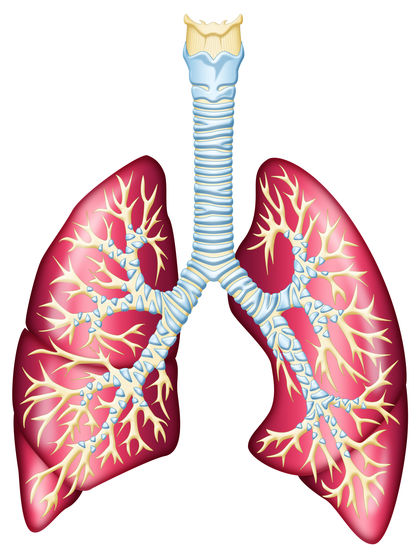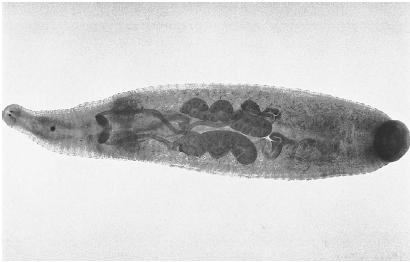Respiration - How it works

Forms of Respiration
Respiration can be defined as the process by which an organism takes in oxygen and releases carbon dioxide, one in which the circulating medium of the organism (e.g., the blood) comes into contact with air or dissolved gases. Either way, this means more or less the same thing as breathing. In some cases, this meaning of the term is extended to the transfer of oxygen from the lungs to the bloodstream and, eventually, into cells or the release of carbon dioxide from cells into the bloodstream and thence to the lungs, from whence it is expelled to the environment. Sometimes a distinction is made between external respiration, or an exchange of gases with the external environment, and internal respiration, an exchange of gases between the body's cells and the blood, in which the blood itself "bathes" the cells with oxygen and receives carbon dioxide to transfer to the environment.
This is just one meaning—albeit a more familiar one—of the word respiration. Respiration also can mean cellular respiration, a series of chemical reactions within cells whereby food is "burned" in the presence of oxygen and converted into carbon dioxide and water. This type of respiration is the reverse of photosynthesis, the process by which plants convert dioxide and water, with the aid of solar energy, into complex organic compounds known as carbohydrates. (For more about carbohydrates and photosynthesis, see Carbohydrates.)
How Gases Move Through the Body
Later in this essay, we discuss some of the ways in which various life-forms breathe, but suffice it to say for the moment—hardly a surprising revelation!—that the human lungs and respiratory system are among the more complex mechanisms for breathing in the animal world. In humans and other animals with relatively complex breathing mechanisms (i.e., lungs or gills), oxygen passes through the breathing apparatus, is absorbed by the bloodstream, and then is converted into an unstable chemical compound (i.e., one that is broken down easily) and carried to cells. When the compound reaches a cell, it is broken down and releases its oxygen, which passes into the cell.
On the "return trip"—that is, the reverse process, which we experience as exhalation—cells release carbon dioxide into the bloodstream, where it is used to form another unstable chemical compound. This compound is carried by the bloodstream back to the gills or lungs, and, at the end of the journey, it breaks down and releases the carbon dioxide to the surrounding environment. Clearly, the one process is a mirror image of the other, with the principal difference being the fact that oxygen is the key chemical component in the intake process, while carbon dioxide plays the same role in the process of outflow.
HEMOGLOBIN AND OTHER COMPOUNDS.
In humans the compound used to transport oxygen is known by the name hemoglobin. Hemoglobin is an iron-containing protein in red blood cells that is responsible for transporting oxygen to the tissues and removing carbon dioxide from them. In the lungs, hemoglobin, known for its deep red color, reacts with oxygen to form oxyhemoglobin. Oxyhemoglobin travels through the bloodstream to cells, where it breaks down to form hemoglobin and oxygen, and the oxygen then passes into cells. On the return trip, hemoglobin combines with carbon dioxide to form carbaminohemoglobin, an unstable compound that, once again, breaks down—only this time it is carbon dioxide that it releases, in this case to the surrounding environment rather than to the cells.
In other species, compounds other than hemoglobin perform a similar function. For example, some types of annelids, or segmented worms, carry a green blood protein called chlorocruorin that functions in the same way as hemoglobin does in humans. And whereas hemoglobin is a molecule with an iron atom at the center, the blood of lobsters and other large crustaceans contains hemocyanin, in which copper occupies the central position. Whatever the substance, the compound it forms with oxygen and carbon dioxide must be unstable, so that it can break down easily to release oxygen to the cells or carbon dioxide to the environment.
Cellular Respiration
Both forms of respiration involve oxygen, but cellular respiration also involves a type of nutrient—materials that supply energy, or the materials for forming new tissue. Among the key nutrients are carbohydrates, naturally occurring compounds that consist of carbon, hydrogen, and oxygen. Included in the carbohydrate group are sugars, starches, cellulose, and various other substances.
Glucose is a simple sugar produced in cells by the breakdown of more complex carbohydrates, including starch, cellulose, and such complex sugars as sucrose (cane or beet sugar) and fructose (fruit sugar). In cellular respiration, an organism oxidizes glucose (i.e., combines it with oxygen) so as to form the energy-rich compound known as adenosine triphosphate (ATP). ATP, critical to metabolism (the breakdown of nutrients to provide energy or form new material), is the compound used by cells to carry out most of their ordinary functions. Among those functions are the production of new cell parts and chemicals, the movement of compounds through cells and the body as a whole, and growth.
In cellular respiration, six molecules of glucose (C 6 H 12 O 6 ) react with six molecules of oxygen (O 2 ) to form six molecules of carbon dioxide (CO 2 ), six molecules of water (H 2 O), and 36 molecules of ATP. This can be represented by the following chemical equation:
6C 6 H 12 O 6 + 6 O 2 → 6 CO 2 + 6 H 2 O + 36 ATP
The process is much more complicated than this equation makes it appear: some two dozen separate chemical reactions are involved in the overall conversion of glucose to carbon dioxide, water, and ATP.
The Mechanics of Breathing
All animals have some mechanism for removing oxygen from the air and transmitting it into the bloodstream, and this same mechanism typically is used to expel carbon dioxide from the bloodstream into the surrounding environment. Types of animal respiration, in order of complexity, include direct diffusion, diffusion into blood, tracheal respiration, respiration with gills, and finally, respiration through lungs. Microbes, fungi, and plants all obtain the oxygen they use for cellular respiration directly from the environment, meaning that there are no intermediate organs or bodily chemicals, such as lungs or blood. More complex organisms, such as sponges, jellyfish, and terrestrial (land) flatworms, all of which have blood, also breathe through direct diffusion. The latter term describes an exchange of oxygen and carbon dioxide directly between an organism, or its bloodstream, and the surrounding environment.
More complex is the method of diffusion into blood whereby oxygen passes through a moist layer of cells on the body surface and then

In tracheal respiration air moves through openings in the body surface called spiracles. It then passes into special breathing tubes called tracheae that extend into the body. The tracheae divide into many small branches that are in contact with muscles and organs. In small insects, air simply moves into the tracheae, while in large insects, body movements assist tracheal air movement. Insects and terrestrial arthropods (land-based organisms with external skeletons) use this method of respiration.
Much more complicated than tracheae, gills are specialized tissues with many infoldings. Each gill is covered by a thin layer of cells and filled with blood capillaries. These capillaries take up oxygen dissolved in water and expel carbon dioxide dissolved in blood. Fish and other aquatic animals use gills, as did the early ancestors of humans and other higher animals. A remnant of this chapter from humans' evolutionary history can be seen in the way that an embryo breathes in its mother's womb, not by drawing in oxygen through its lungs but through gill-like mechanisms that disappear as the embryo develops.
LUNGS.
Lungs are composed of many small chambers or air sacs surrounded by blood capillaries. Thus, they work with the circulatory system, which transports oxygen from inhaled air to all tissues of the body and also transports carbon dioxide from body cells to the lungs to be exhaled. After air enters the lungs, oxygen moves into the bloodstream through the walls of these capillaries. It then passes from the lung capillaries to the different muscles and organs of the body.
Although they are common to amphibians, reptiles, birds, and mammals, lungs differ enormously throughout the animal kingdom. Frogs, for instance, have balloon-like lungs that do not have a very large surface area. By contrast, if the entire surface of an adult male human's lungs were spread flat, it would cover about 750 sq. ft. (70 m 2 ), approximately the size of a handball court. The reason is that humans have about 300 million gas-filled alveoli, tiny protrusions inside the lungs that greatly expand the surface area for gas exchange.
Birds have specialized lungs that use a mechanism called crosscurrent exchange, which allows air to flow in one direction only, making for more efficient oxygen exchange. They have some eight thin-walled air sacs attached to their lungs, and when they inhale, air passes through a tube called the bronchus and enters posterior air sacs—that is, sacs located toward the rear. At the same time, air in the lungs moves forward to anterior air sacs, or ones located near the bird's front. When the bird exhales, air from the rear air sacs moves to the outside environment, while air from the front moves into the lungs. This efficient system moves air forward through the lungs when the bird inhales and exhales and makes it possible for birds to fly at high altitudes, where the air has a low oxygen content.
Humans and other mammals have lungs in which air moves in and out through the same pathway. This is true even of dolphins and whales, though they differ from humans in that they do not take in nutrition through the same opening. In fact, terrestrial mammals, such as the human, horse, or dog, are some of the only creatures that possess two large respiratory openings: one purely for breathing and smelling and the other for the intake of nutrients as well as air (i.e., oxygen in and carbon dioxide out).